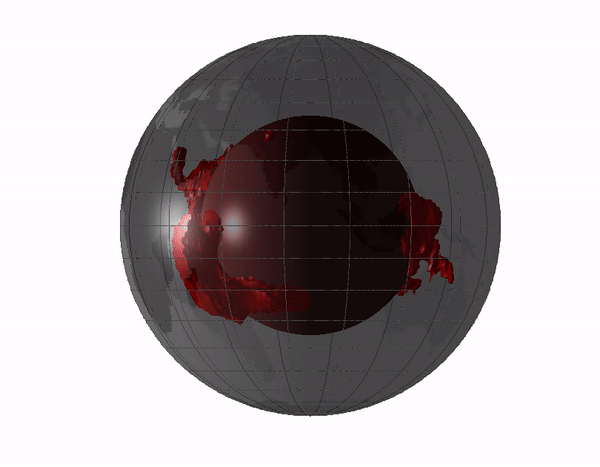
CC BY-SA 4.0, Source |

These regions are 0.5% denser than the mantle surrounding these plumes. The plume appearing under the Indian Ocean and extending from Africa appear to be more massive than the mid-Pacific plume.
As the Earth rotates, these regions continue on the horizontal plane, but as these structures grow, they will introduce instability.
In this video, you will receive an explanation of the Dzhanibekov Effect. When rotating objects have unequal mass distribution, they can flip suddenly to a different angle due to the Moment of Inertia. If the Earth's core were perfectly symmetrical (round), there wouldn't be a problem. Our core with these plumes is an asymmetric top, having multiple moments of inertia. Is there a way to understand why this is important to know?

In this illustration, the larger blocks represent LLSVPs, while smaller blocks represent the polar ice packs. Under normal conditions, the spin will be stable. If something nudges the polar regions, they will start to move. "The minor centrifugal forces will start to accelerate them." Over one hundred and fifty years ago, we experienced a nudge.

Using my inimitable skills at drawing in MS Paint, I created a rough sketch of the Milky Way (not to scale). A layer of dust spirals from the heart of the Milky Way along the galactic plane. Our Solar system orbits vertically through this dust layer every twelve thousand years. It isn't easy to develop a metaphor describing the mechanisms occurring on the sun occurring during this period. Star systems the size of ours are capable of creating elements up to the level of iron. Heavier elements such as gold etc., do not originate in our system. Supernovas have sufficient gravity to create these more serious elements. The center of our galaxy would make the entire range of elements and eject them all into the "dust cloud". As our solar system orbits through this could, the particles are attracted to the sun. Once a trigger goes off, our star ejects the accumulation of particles in a shell, similar to the ejection from the galactic center.
This image of Boyajian's Star (1,470 light-years from Earth) shows what we cannot see of our sun - its layer of dust.
The irony is that we are only just attaining the technology to describe and understand the processes that are going on. Since the Carrington Event (which signalled our entrance into the galactic dust cloud, the magnetic pole has been moving. Does this mean that we are heading toward a planetary Dzhanibekov Effect? That isn't necessarily the case. The mass of the LLSVP is not evenly distributed. Instead of a complete inversion, it is likely that it will only be tilting.
There is one thing to remember, even if the tilt is twenty degrees. Take a balloon and squash it against a table. The mass of the ocean waters is in this shape due to the centrifugal forces propelling it away from the center.
What happens if the position of the poles moves. Areas currently above water will be buried under the new bulge.

Nice
Downvoting a post can decrease pending rewards and make it less visible. Common reasons:
Submit